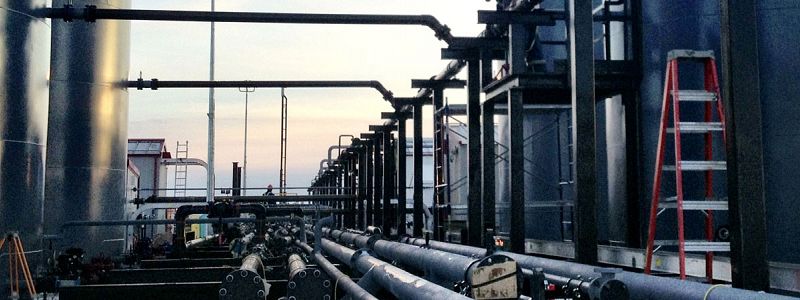Applications
- Low Pressure Battery and Facility Piping
- Vapour Recovery Lines
- Vent Lines
- Flare Lines
- Tank Internals
- Water Handling (Frac, Processing, Transfer, Cooling Lines)
- Condensate Return
- Industrial Wastewater
- CO2
- Brine and brackish water
- Chemical process piping
Completion and Production Solutions
Product Description
Red Thread HP pipe is a filament wound product constructed of epoxy resins and continuous glass filaments. Red Thread HP pipe is designed in accordance with API 15LR. Pipe and fittings are available in diameters of 2” through 42”, with pressure ratings up to 435 psig (30.0 barg) static pressure rating. The maximum operating temperature for Red Thread is 210° F (99° C). Compatible epoxy fittings are manufactured with the same pressure and temperature capabilities as the pipe. Depending on the application and the particular part and size, fittings will be compression molded, contact molded, hand fabricated or filament wound.
Materials and Construction
Red Thread HP16 pipe is manufactured by the filament winding process using aromatic amine-cured epoxy thermosetting resin to impregnate strands of continuous glass filaments. The pipe is rated up to 435 psig in accordance with API 15LR, 20 year design life at 200°F (93°C), serviceable up to 210°F (99°C) by applying a derating factor of 0.92 to all component ratings.
ASTM D-2996 Classification: RTRP-11AW1-3110 for static design basis.
Fittings
Fittings are manufactured with the same chemical and temperature capabilities as the pipe. Depending on the configurations and size, the fittings construction method will be compression molded, contact molded, fabricated or filament wound. Fittings details are in two documents. Use CI1350 for sizes
2”-16” (50-400 mm) and CI1351 for 18”-42” (450- 1050 mm). All fittings may not have the same pressure rating as the pipe. System rating is governed by the lowest rated component used.
Performance
- Working pressure to 450 psig depending on pipe size.
- Temperatures to 210°F (99°C) maximum. Sub-zero temperatures will not affect the physical properties.
- Recommended for water, waste water (pH 1 to 12), moderately corrosive liquids and mild chemicals.
- Consult Chemical Resistance Guide or Applications Engineering for recommendations for your particular application.
- Individual system components may not have the same ratings as the pipe. Refer to the detailed product information for the specific components to determine the pressure rating for the system as a whole.
Performance
- Pipe and fittings are rated at 200 psig.
- Operating plus surge pressures to 1.25 times rated operating pressure occurring three times or less per 24-hour period.
- Temperatures to 210°F (99°C) maximum. Sub-zero temperatures will not affect the physical properties.
- Recommended for water, waste water (pH 1 to 12), and mild chemicals. Consult Chemical Resistance Guide or contact NOV Fiber Glass Systems for recommendations for your particular application.
- Individual system components may not have the same ratings as the pipe. Refer to the detailed product information for the specific components to determine the pressure rating for the system as a whole.
Product Description
For Bondstrand™ pipe systems 3000, 3200, 3300, 3000A, 3200A and 3300A
Standard end configurations: Bell end is standard configurations. All other end configurations, including size reductions, are made to order.
Taper angle: Taper angle on all bell x spigot end configurations is 13/4° for 2 through 6 inch nominal and 2° for sizes 8 through 16 inch pipe sizes.
Manufacturing methods: The fiberglass-reinforced epoxy resin fittings shown in this publication are manufactured by the methods as indicated - Filament winding, Compression molding, Centrifugal casting and Contact molding.
Pressure ratings: See the appropriate Bondstrand Product Data sheet for pressure ratings.
Individual system components may not have the same ratings as the pipe. Refer to the detailed product information for the specific components to determine the pressure rating for the system as a whole.


